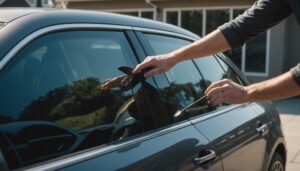You might be surprised to learn that the cost of tinting your car windows can vary widely based on several factors. From the size of your vehicle to the type of tint and even the installation process, each aspect can greatly impact your final bill. If you’re considering this upgrade, you’ll want to understand these variables and how they can affect your budget. What should you keep in mind to make the best decision for your needs?
Key Takeaways
- Window tinting costs typically range from $100 to $600, influenced by vehicle size and type.
- Smaller cars generally cost between $100 to $300 to tint, while larger vehicles range from $300 to $600.
- The type of film chosen—dye-based, metalized, ceramic, or carbon—affects prices and longevity of the tint.
- Professional installation may incur additional costs but ensures high-quality results and warranties.
- Legal regulations on tint levels vary by region, which can impact allowable materials and costs.
Factors Influencing Window Tinting Costs

When you’re considering window tinting for your car, several factors can affect the overall cost. First, regions have different regulations and average pricing, so where you live plays a role. Next, the size and type of your vehicle are vital; larger cars usually cost more to tint. The complexity of the installation can also influence prices, particularly for cars with unique window shapes.
Moreover, the quality of the film you choose greatly impacts the price. Premium films with advanced features, like UV protection and heat rejection, tend to cost more upfront but can save you money in the long run by preserving your interior.
Finally, labor costs vary by installer; choosing a well-reviewed professional can guarantee better results, but it might come with a higher price tag. Always weigh these factors before making your decision to guarantee you’re getting the best value.
Different Types of Window Tint

Choosing the right type of window tint can greatly enhance your driving experience. There are several types to examine, each with its unique benefits.
Firstly, dye-based tints offer a budget-friendly option, providing a sleek look and reducing glare. However, they may fade over time.
Next, metalized tints feature tiny metallic particles that help reflect heat and UV rays, enhancing comfort and protecting your interior. They’re durable and less prone to fading, but their shiny finish could interfere with radio signals.
Ceramic tints represent the premium choice, utilizing advanced technology that blocks heat without darkening your windows excessively. They’re non-reflective, ensuring privacy without compromising visibility.
Lastly, carbon tint provides a rich look while effectively blocking UV rays and heat, making it a popular choice. Evaluating these options will help you determine what’s best for your vehicle and lifestyle.
Cost Breakdown by Vehicle Size

Selecting the right window tint isn’t just about the type; the cost can vary markedly based on your vehicle’s size. Generally, smaller cars are less expensive to tint, often ranging from $100 to $300. This lower cost reflects fewer windows and a simpler installation process.
On the other hand, larger vehicles like SUVs or vans usually have a higher price tag, typically falling between $300 and $600. The increased expense accounts for additional windows and more complex angles that require detailed work from the technician.
If you drive a luxury or high-end model, expect to pay at the higher end of these ranges due to the need for specialized care and high-quality materials. Understanding these cost breakdowns not only helps you budget better but also aids in making a more informed decision about your window tinting needs.
Price Differences by Tint Brand
While comparing window tint options, you’ll notice that prices can vary considerably depending on the brand you choose. Premium brands like 3M and Llumar often come with higher price tags due to their advanced technology and durability. These brands use high-quality materials that can offer better heat rejection and UV protection, making your investment worthwhile in the long run.
On the other hand, more budget-friendly options, like SolarGard or Gila, may save you money upfront, but they often lack the same level of performance or longevity. You’ll want to balance your budget with your needs; if you plan to keep your vehicle for years, splurging on a reputable brand may pay off.
Ultimately, researching each brand’s offerings will help you determine which tint aligns with your priorities and budget. Remember, investing in a quality tint now can save you costs related to replacement or repairs later.
DIY vs. Professional Tinting Services
Whether you’re a DIY enthusiast or prefer to leave it to the pros, the choice between DIY and professional tinting services can greatly impact your car’s appearance and functionality. If you decide to go the DIY route, you’ll save money on labor costs and have the satisfaction of completing the project yourself. However, be prepared for the learning curve; achieving a flawless finish can be tricky, and you might need to invest in quality materials and tools.
On the other hand, hiring professionals offers expertise and higher-quality results. They’ve mastered the art of tinting and can guarantee a perfect application without bubbles or imperfections. Plus, many professional services come with a warranty, providing peace of mind that your investment is protected. Ultimately, your decision should factor in your budget, skill level, and the look you’re aiming for. Choose wisely to enjoy your tinted windows to the fullest!
Regional Price Variations
The cost of tinting your car windows can vary greatly based on where you live. In urban areas, for instance, you might find higher prices due to increased demand and cost of living. If you’re in a city with a competitive market, you might snag a better deal, while rural areas often have fewer options, potentially leading to higher prices.
Additionally, regional laws about window tinting can also affect costs. Some states have strict regulations that might demand specialized films, which could increase your overall expense. Climate can play a role, too—areas with intense sunlight may drive demand for quality tinting, pushing prices up.
Additional Costs to Consider
Although you might be focused on the base cost of tinting your car windows, there are several additional expenses to keep in mind. First, if you choose to opt for a higher-quality film, the price can increase considerably. Expect to pay extra for premium shades, which can enhance durability and aesthetic appeal.
Next, consider installation costs; if you go to a professional, labor fees may add to your total. Some shops offer warranties, which might entail an additional charge, but they can provide peace of mind. If you plan to remove old tint before applying new film, factor in those costs too.
Finally, local regulations may require you to invest in additional inspections or certifications, especially if you’re tinting to legal limits. By accounting for these potential expenses, you’ll better understand the overall financial commitment involved in window tinting.
Benefits of Investing in Quality Tint
Investing in quality tint for your car windows can transform your driving experience in numerous ways. First, it enhances privacy, making it harder for prying eyes to see inside your vehicle, which can deter theft and give you peace of mind. Second, quality tint blocks harmful UV rays, reducing your risk of skin cancer and protecting your car’s interior from fading.
Additionally, it helps regulate temperature by keeping your vehicle cooler in the summer, which boosts air conditioning efficiency and saves you on fuel costs. You’ll also enjoy a more comfortable ride without the harsh glare that comes from direct sunlight.
Furthermore, premium tints often come with warranties, ensuring you receive a lasting product that maintains its appearance over time. Ultimately, investing in quality window tint not only elevates your driving experience but also protects you and your vehicle for years to come.
Legal Regulations on Window Tinting
Maneuvering through the legal landscape of window tinting can feel overwhelming, but understanding the regulations is essential for any car owner. Each state has its own laws governing the darkness and reflectivity of window tint. You’ll need to check the specific restrictions for your location, as they can vary widely. For instance, some states allow darker tints on rear windows but restrict front windows to lighter shades.
Additionally, certain types of window tint materials may be disallowed or require certification. Failing to comply with these regulations can result in fines or, worse, requiring you to remove the tint altogether.
Make sure to research your local laws before you invest in tinting. It’s also a good idea to consult a professional tinting service who stays updated on legal requirements. Staying informed will help you enjoy the benefits of window tinting without the headache of legal issues down the road.
Estimating Your Tinting Budget
When you’re planning to tint your car windows, it’s essential to have a clear budget in mind. Start by researching the average costs in your area, which can range from $100 to $400, depending on factors like the type of tint, the number of windows, and the vehicle size. Consider whether you want basic film or premium options with UV protection.
Don’t forget to include potential additional costs like professional installation, as DIY can lead to subpar results. Factor in any legal requirements or regulations that may influence pricing, too.
Always allocate some funds for unexpected expenses, like repairs to the windows or issues during installation. By estimating your tinting budget accurately, you’ll be well-prepared to make a smart investment that enhances your vehicle’s look while ensuring you stay within your financial limits.
Frequently Asked Questions
How Long Does Window Tinting Last on Average?
Window tinting can last anywhere from five to ten years, depending on the quality of the film and how well you maintain it. If you choose premium materials and install them correctly, you’ll likely enjoy the benefits for longer. Regular cleaning and avoiding harsh chemicals can extend the lifespan. Remember, environmental factors like sunlight intensity and temperature fluctuations can also affect your tint’s durability over time. So, care for it well!
Can I Remove Window Tint Myself?
Yes, you can remove window tint yourself, but it can be a bit tricky. Start by heating the tint with a hairdryer to loosen the adhesive. Once it’s warmed up, carefully peel it off using a razor blade or scraper. Be cautious not to damage the glass. After removing the tint, clean the windows thoroughly to eliminate any residue. If it seems overwhelming, consider hiring a professional for a smoother process.
What Are Common Maintenance Tips for Tinted Windows?
To maintain your tinted windows, you should avoid harsh chemicals; use a gentle soap and water solution instead. Clean the windows with a microfiber cloth to prevent scratches. Don’t roll down the windows for at least a week after installation to allow the tint to cure fully. Regularly check for peeling or bubbling, and address any issues promptly to preserve the look and function of your tint. Taking these steps can extend its lifespan remarkably!
Will Window Tinting Affect My Car’s Warranty?
Oh, you might think tinting your windows is like launching your car’s warranty into outer space! But fear not; generally, a professionally installed window tint won’t void your car’s warranty. However, it’s essential to check specific terms with your manufacturer or dealer. If you choose high-quality film and proper installation, you’ll keep your warranty intact while enjoying that sleek, stylish look and protecting your interior from harmful sun damage.
Are There Any Health Benefits to Window Tinting?
Yes, there are health benefits to window tinting! By blocking up to 99% of harmful UV rays, your skin’s protection increases, reducing the risk of sunburn and long-term skin damage. You’ll also notice a decrease in glare, which can help with eye strain and fatigue while driving. With cooler temperatures inside your car, you’re likely to feel more comfortable and enjoy a safer, more pleasant driving experience overall.













